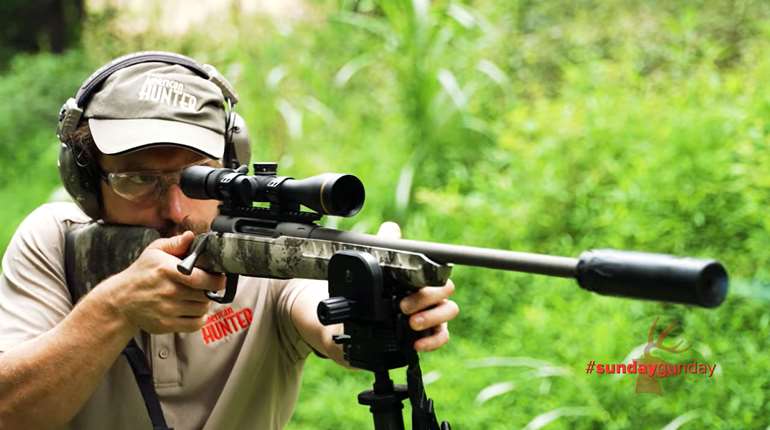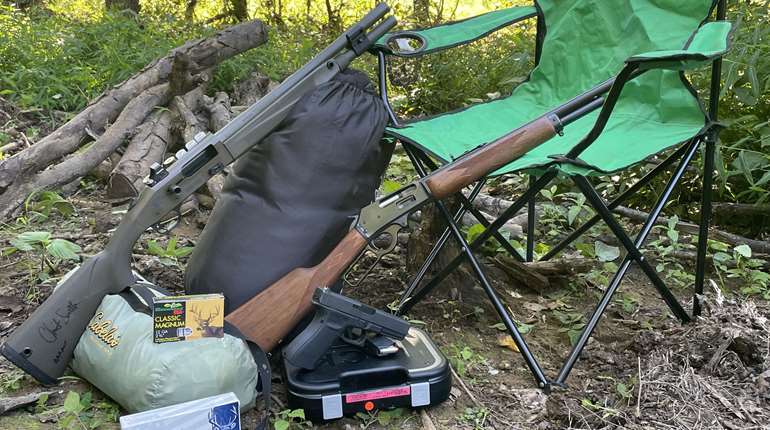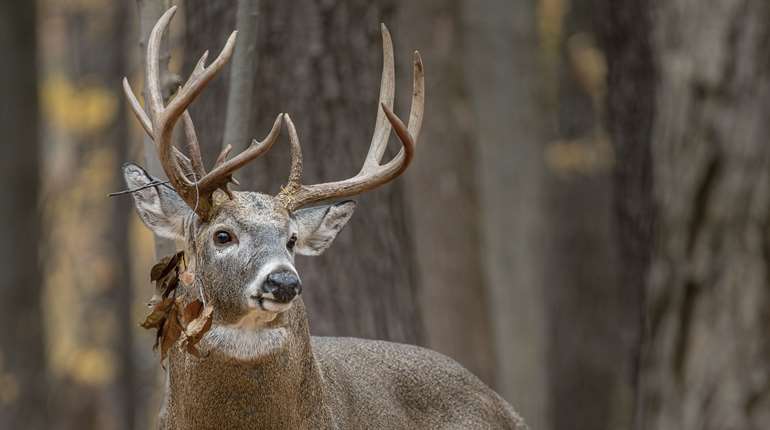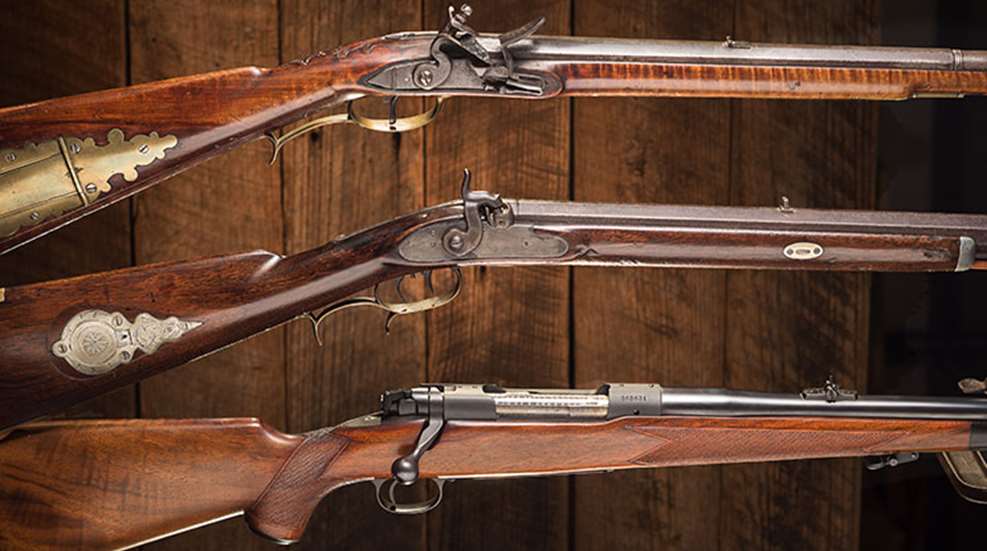
“The early American rifle dates back to the beginning of America itself. This country was born with the rifle in its hand.”
—Philip B. Sharpe, 1938
On April 24, 1607, 143 men from England disembarked from three ships onto what we now call Jamestown, Va., establishing the first permanent English colony in North America. In the intervening 411 years that modest colony has grown into the most prosperous nation on Earth, and our survival and economic prosperity are due in no small fact to the use and development of firearms. The catalyst to this success has been the evolution of the hunting rifle over the past four centuries.
The first settlers to this country came armed. Well armed. They provided themselves with the best means of defense available to them at the time for they knew that in order for their colony to succeed they would need to defend it and live off the wild game the area provided.
To understand the hunting rifle in America we might take a quick look back to examine the development of firearms in general. Gunpowder was first recorded in the writings of Roger Bacon in the last years of the 13th century. Some scholars theorize the Chinese developed what became known as black powder as a pyrotechnic and a fireworks propellant as early as 900 A.D. The first known projectile-firing gun, as we understand them today, is a Chinese example dated to the year 1288. The Chinese did not further the development nor did they recognize the potential use of firearms until long after arms had been refined in Europe in the early 1300s. The development of firearms initially was the development of cannon or artillery; “handgonnes” evolved as an off-shoot of cannon designs.
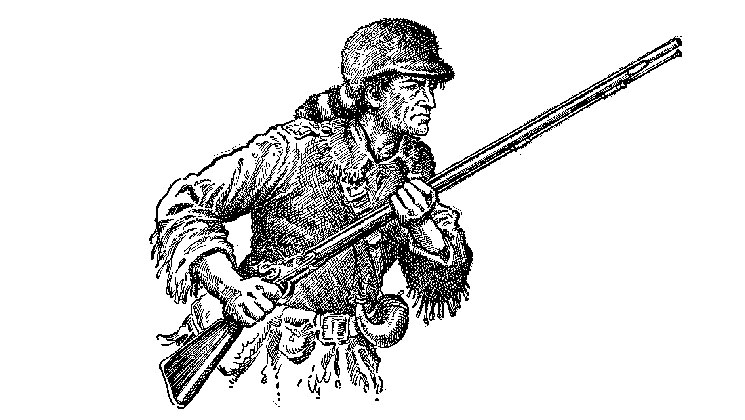
The Colonial Period
By the time the Susan Constant, Godspeed and Discovery left England bound for Jamestown in 1606, their complement of arms consisted of numerous cannons, deck guns and small arms intended for use by the settlers to fortify their fledgling colony. Their firearms were matchlocks and wheellocks of European make. Archeological digs at Jamestown have yielded numerous examples of both types of ignition systems, confirming the widespread use of these types of arms by the early militia and settlers.
A matchlock is a rather simple mechanism that holds a lit slow-match in a clamp that can be lowered into a flash pan at the breech of the barrel to provide ignition to the main powder charge in the gun. The wheellock was a more expensive and complicated affair. Designed by Leonardo da Vinci in 1500, the wheellock required the user to wind the lock, much like a watch mechanism, to put a great deal of tension into a coil spring. Pulling the trigger released the spring, causing a serrated wheel to spin against a piece of pyrite held firmly in the jaws of a clamp. The resulting shower of sparks ignited the priming powder in the frizzen pan, thus firing the main charge. It’s the same system used today to light a standard Zippo lighter, but without the spring tension of course. The Dutch writer and illustrator Jakob de Gheyn illustrates both types of firearms in common use in his famous "Manual of Arms" treatise of 1606, the same year the Jamestown settlers disembarked from England, bound for the New World. Trading for food with the local native Indians and hunting wild game was the only thing that kept the early settlers alive thorough the harsh first years of settlement. Sadly for them, even wild game proved to be elusive as the Virginia region was suffering from a long and severe drought that predated their arrival. Their firearms were to be of greater use in defending the lonely outpost from Indian attacks than they were for hunting.
Soon the colonies saw an influx of supplies and additional settlers from all ports in Europe, enough that by the early 1700s European settlements on the East Coast were stable and burgeoning. With the new settlers and prospering towns came tradesmen working to provide the essentials needed to survive—and skilled gunsmiths were essential to each community.
With these new arrivals came their Old World skills and traditions, especially as colonies became virtual melting pots of ideas and customs. Germanic settlers in Pennsylvania brought with them rifled firearms, which soon evolved into the classic American longrifle.
Rifling was developed in Germany in the late 1400s and early 1500s; numerous known examples date to the 1540s. The cutting of lands and grooves inside the barrel was found to give the projectile greater stability and accuracy as well as increased range. The Spanish writer Alonzo Martinez de Espinar wrote in 1644 about wrapping the ball (projectile) in a greased patch, which not only provided the shooter with a method to seat a lubricated round in the breech with greater ease but also provided somewhat of a gas check to take advantage of every foot-pound of pressure generated by the charge. The earliest examples of rifling include straight lands and grooves; the idea of twisting the rifling came some decades later when greater study of the bullet in its flight had been observed. Sights began to appear on the new styles of guns that had previously only been pointed in the general direction of the intended target.
In 1630, Eltweed Pomeroy, of Dorchester, Mass., is credited with establishing one of the first gunsmithing shops in the colonies, with others following in 1635 (Maryland), 1646 (New York), 1685 (Carolinas) and 1697 (Connecticut). These gunsmiths at first were only repairing and supplying shooters with needed accoutrements; it wasn’t until 1710 that Martin Meylin was making what we now call Pennsylvania rifles in Lancaster, Pa.
Although the longrifle has become an iconic American symbol, it has been variously referred to as the Pennsylvania or Kentucky rifle. While gunmakers in Pennsylvania certainly are to be credited with evolving the Old World Jaeger rifle into the longrifle of folklore, rifles themselves were quite common from Pennsylvania to points well south and deep into the Carolinas.
Lord Dunmore’s War of 1774 was a conflict actually fought between colonists and Indians over the ability to hunt on and access the rich hunting areas in the Ohio Valley area that is now western Pennsylvania, West Virginia and eastern Ohio. Riflemen of the Virginia regiments who participated in that war were some of the first present during the siege of Boston a year later following the Battles of Lexington and Concord. Their rifles were an object of awe and admiration to the local New Englanders, as well as their British counterparts who suffered mercilessly under their withering fire. So alarmed were the British that they ordered the capture of a rifleman and his rifle for observation. Such was sent back to England for assessment; an entire series of tests was conducted at the Woolwich Arsenal, where rifled arms were found to be decidedly more accurate than the issue Brown Bess, a smoothbore. Although the popular myth of the New England Minuteman is one of a farmer well acquainted with his squirrel rifle defending home and hearth with his trusty gun, the earliest known New England rifle was made by Thomas Tileston of Duxbury, Mass., in 1773. Of the hundreds of fired bullets excavated from the battle sites of Lexington and Concord, none have been found with the telltale marks of rifling nor were any of the participants known to have had rifles at the time.
Certainly the efficacy of the rifle in battle made converts of the many veterans who returned home and took up life again as hunters providing sustenance for their families. The post War for Independence era has become known as the Golden Age of rifle manufacture in the newly formed United States of America.
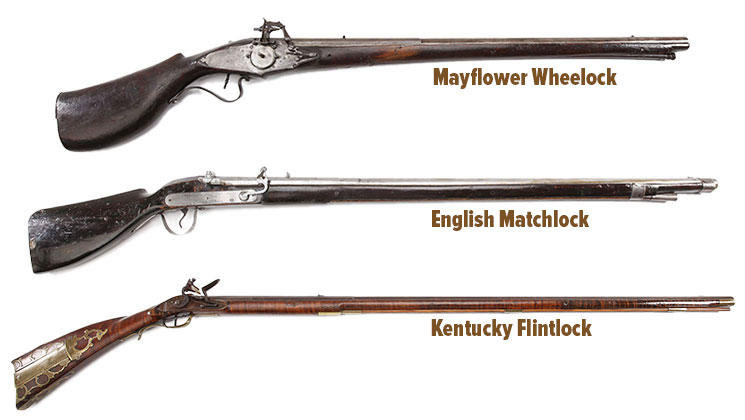
The Golden Age
The flintlock mechanism began to supplant the wheellock, snaphaunce and miqulet styles of ignition systems by the mid-1600s. The combination of flintlocks and the advancement in rifling gave the hunter a decidedly upper hand in range and accuracy, as so effectively demonstrated during the American Revolution.
Gunsmiths in the Lancaster region of Pennsylvania are credited with developing the “Pennsylvania Longrifle” in the early 1700s. The family of a noted Pennsylvania gunmaker, George Schreier Sr. (this author’s indirect ancestor) arrived in Lancaster from Germany in 1725; George was born here in 1739, beginning his apprenticeship as a gunsmith when he was 14 years old. Like many gunmakers of the “Golden Age” (1770-1820), Schreier was known for turning a rifle into a beautiful work of art. The addition of brass patch boxes, inlayed wire decorations, silver finials, raised cheekpieces and relief carving turned a hunters' utilitarian tool into a priceless piece of American folk art.
Hunters employed gunsmiths close to home to provide them with the necessary tools of the trade during this era. As the guild system of apprenticeships was still very much a way of life in the Colonies and well into the early Federalist period, gunsmiths had particular styles and methods of making their guns that reflected the needs and desires of their particular regions. It’s easy, to the well practiced eye, to tell if a longrifle was made by Pennsylvania artists or by those working in Virginia or the Carolinas just by looking at the drop in the comb of the stock or the style and type of embellishments made to the final product.
Some gunsmiths working from their own iron forges were able to turn out such superior products that these small “mom-and-pop” gunmakers were able to capitalize and expand their businesses into fully fledged factories. Such was the future for Eliphalet Remington (1793-1861), who began working in the gun trade in Ilion, N.Y., in 1816.
The end of the flintlock era came following the Rev. Alexander Forsyth’s Scottish patent of the percussion cap in 1807. Using fulminates of mercury that produced a spark when hit sharply, a percussion cap enabled the shooter to finally utilize his firearm in all kinds of weather, where the previous system of an exposed frizzen pan was always subject to doses of high humidity and useless in the driving rain. Forsyth’s patent would also lay the groundwork for the development of the rimfire and centerfire cartridges still in use by hunters to this very day.
Westward, Ho
Henry Hawken (1760-1820) first started making fine rifles in Lancaster, Pa., and moved to Hagerstown, Md., in 1787. His sons, Jacob (1786-1849) and Samuel (1792-1884), established a gun shop in St. Louis, Mo., in the early 1820s, providing the westward pioneer with a new style of rifle more suited to the open plains than the woods of the Eastern Seaboard. These half-stocked and heavy-barreled rifles became known as Plains Rifles; signed examples are highly desired by collectors today. The mountain men and fur trappers who opened the West treasured these “plain” rifles that suited their rugged lifestyle of function over form.
With the discovery of gold in California in 1849, the flood of pioneers and prospectors moving west came at the exact time in history that America began to become industrialized. This confluence of events and the advancement of technology soon made firearms not only indispensable to the pioneer but also affordable to folks of every economic background.
In 1785, Thomas Jefferson wrote to future jurist John Jay about a conversation he had with a French armsmaker. Henri Blanc worked at the Saint-Etienne arms manufactory and explained to Jefferson how machines could be crafted to produce individual parts of identical nature so that they would be capable of being interchanged as parts in a firearm. Once enough machines were supplied to create each component part, a relatively unskilled workman could assemble complete guns without the need to hand fit everything. Not only would this accelerate manufacturing but it also made the repair of broken parts easier by replacing them with identically made parts.
Jefferson’s ideas were made into reality when gunmakers like John Hall of Virginia, and Simeon North, Eli Whitney Sr. and Eli Whitney Jr. of Connecticut began to establish factories to mass produce firearms. By 1847, working on an order of 1,000 revolvers placed by Texas Ranger Samuel Hamilton Walker, Eli Whitney Jr. and Col. Sam Colt were able to produce one of the first mass-produced products in the world.
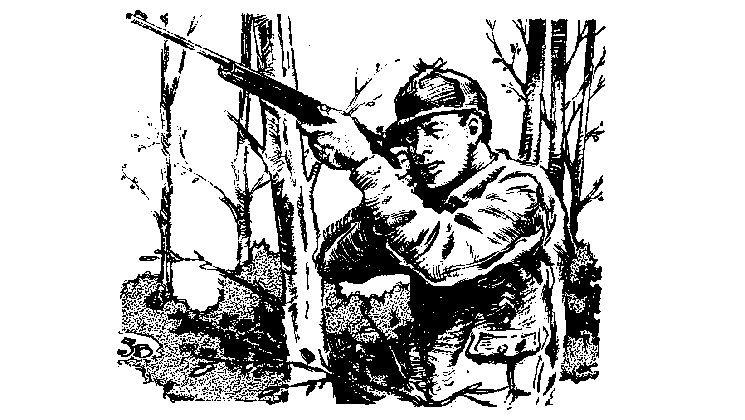
An Age of Industry
It wasn’t long before factories began to turn out rifles in staggering numbers as well. During the Civil War (1861-1865), 33 factories in the North turned out a staggering 1.3 million Springfield rifles in just 48 months. While military rifles and their production is outside the scope of this article, they have heavily impacted the development of hunting rifles ever since.
Following the war, hundreds of thousands of rifles were declared surplus by the U.S. military and sold through dealers such as Francis Bannerman & Sons in New York. A surplus Springfield could be purchased for $1.50 where before the war a custom Hawken rifle would sell for $25 in the store and many times that on the open market, where demand for the rifles outstripped production capabilities of the brothers.
Some historians would argue the most popular and prolific of all hunting arms in the late 19th century, in fact the gun that truly “won the West,” was a double-barreled shotgun. Certainly the cost and the numbers manufactured and imported support this theory—that while well-made rifles were desirable, it was the shotgun that was considered indispensable and affordable to every pioneer headed west.
Another collateral effect of the war was the effect it had on the industrialized gunmakers of the North. Firms like Remington, Winchester and others began to look to hunters in the civilian marketplace to purchase their products in the wake of lost contracts from the U.S. government. The development of the self-contained metallic cartridge added to the attraction of buying a newly made factory rifle vs. an old percussion muzzleloader of the Civil War era. Breechloading arms became more practical with the advent of self-contained metallic cartridges. Winchester pioneered the magazine-fed, cartridge-firing civilian hunting rifle with the introduction of the Model of 1866. Various models of these accurate and well-made rifles flowed freely from Winchester’s factory in New Haven, Conn., for more than 130 years. The models of 1866 and 1873 were chambered in low-velocity pistol cartridges, but answering the needs of hunters across the country, the models of 1876 and 1886 offered chamberings in higher-power big-game rounds like the .45-70 and .50-100 that were suitable to the buffalo hunters of the 1870s and ’80s.
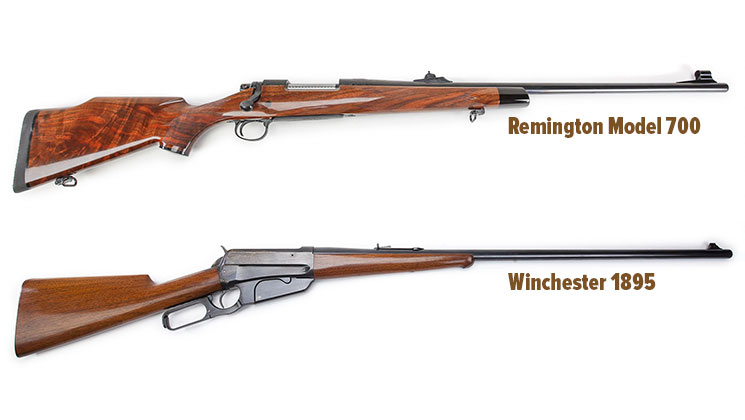
The Modern Era
The advent of the modern hunting rifle may have very well been facilitated by none other than the Remington Arms Company of Ilion, N.Y. The company’s popular Model 700, introduced in 1962, is currently available in 34 different styles and has been made in more than 30 chamberings. With more than 5 million sold so far, it is the most prolific hunting rifle ever made. The twin-lug bolt-action mechanism is a refinement of one developed by the Mauser Brothers nearly a century earlier. Franz Mauser, one of 13 siblings that included brothers Wilhelm and Paul, immigrated to the United States before the Civil War and found employment at Remington Arms. It was here that Samuel Norris, a Remington salesman, became acquainted with the German brothers and their efforts to convert French Chassepot needle-fire guns into bolt-action rifles that accepted cartridges. Their first firearm patents were taken out in 1867 by Norris, and the Mausers were on their way to changing the entire world of rifles.
The 1880s brought about rapid changes in firearm manufacturing as well as ammunition development. For pretty much the previous 500 years, projectiles had remained relatively unchanged from the round lead balls in use since shortly after the introduction of guns in the 1300s. In 1847, Capt. Claude-Etienne Minié of France designed a projectile with a pointed nose and a hollow base. Refined in 1855 by James H. Burton of the Harpers Ferry Arsenal, the Minié ball became the standard projectile in use by both the North and the South during the Civil War. The elongated, pointed round gave the hunter greater performance and accuracy than the previous method of patching a round ball. The hollow base allowed the force of the expanding gases from the propellant to force the skirt of the bullet into the grooves of the rifling. While the longrifle gave good performance at distances of up to 100 yards, with some shots by frontiersman Daniel Boone recorded at nearly 300 yards, the Minié ball was effective at ranges approaching 1,000 yards.
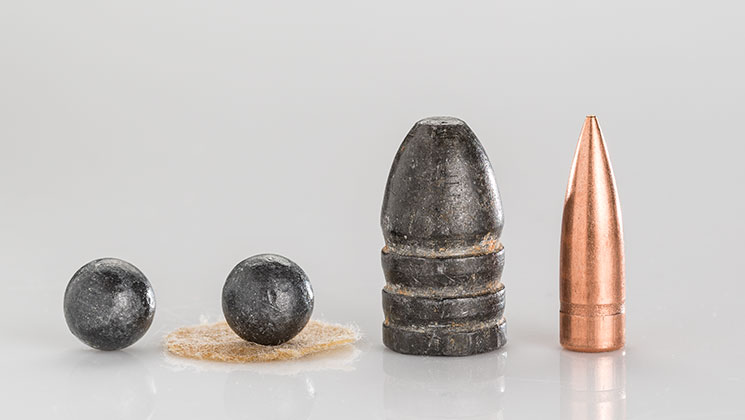
The introduction of smokeless powder in the 1880s tremendously advanced the development of hunting ammunition and the guns that fired them. Nitrocellulose- and cordite-based powders rapidly replaced black powder as the primary propellant for firearms. Three-times as powerful and with a slower burning rate than black powder, the new smokeless powder eliminated the age-old problem of fouling and residue in the old blackpowder guns. The lack of fouling and higher breech pressures enabled firearm designers to develop actions that would not become gummed up with powder residue. The higher pressures produced flatter bullet flight trajectory; a pointed nose, or spitzer round, produced less wind resistance; and smaller-diameter bullets traveled a lot farther and faster with greater accuracy.
No work on a topic such as this would be complete without mentioning the myriad of contributions that John Moses Browning (1855-1926) contributed to firearm development. His 136 patents for improvements to firearms are a small testament to his legendary and prolific genius. In addition to designing the famous Winchester High Wall Model 1885 rifle, he subsequently designed Winchester’s Model of 1886 and the models of 1892, 1894 and 1895.
The Model 1895, this author’s favorite hunting rifle, was Browning’s effort to adapt high-power smokeless cartridges to a lever action that utilized a box magazine as opposed to the traditional tubular magazines that were staples on previous Winchesters. The 1895 had possibly the greatest patron to ever endorse a rifle when Theodore Roosevelt wrote, “The Winchester stocked and sighted to suit myself is by all odds the best weapon I ever had, and I now use it almost exclusively ... .” His adoration of Browning’s 1895 thrilled hunters everywhere when he wrote of his hunting exploits in Africa in 1910: “The Winchester .405 is, at least for me personally, the medicine gun for lions.”

Browning also designed the first semi-automatic rifle developed for civilian use and hunting. The Remington Model 8 was manufactured initially by FN in Belgium in 1900 and marketed by the Remington Arms Co. as the Model 8 from 1906-1950. Winchester’s Model 1905 and Model 1907 competed with the Remington Model 8 for hunters who wanted to use a semi-automatic. The relatively new technology of a semi-auto rifle was, and some consider still is, less accurate than a bolt-action rifle. In 1924, Winchester introduced the Model 54, which utilized the bolt-action design of the Mauser brothers’ classic Model 1898. A rework of the Model 54’s trigger and design features resulted in the introduction of the venerable Model 70 in 1936. Nicknamed “The Rifleman’s Rifle,” the Winchester Model 70 is considered by many to be one of the finest hunting rifles ever manufactured.
Just as surplus Civil War rifles made for inexpensive hunting rifles in the 1860s, surplus and veteran bring-back rifles of the World War II era gave rise to “sporterizing” military arms for civilian use. An economical way of fielding a .30-06 or 8mm hunting rifle, sporterizing old military rifles not only helped put more hunters in the field following the war but it also gave rise to numerous companies like Brownells (est. 1939) that supplied professional and do-it-yourself gunsmiths with tools and components to create many a hunting rifle far below the retail value of a new Winchester Model 70 or a Remington Model 700.
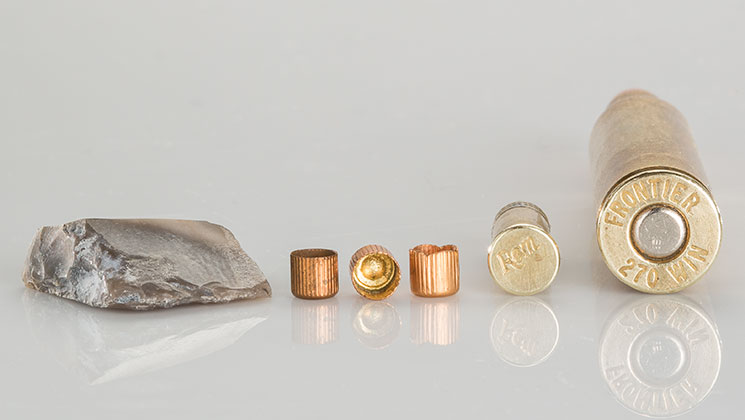
Most historians will agree that many advancements in military hardware are researched and developed by the government and then, after proving themselves in the field, are used and/or converted to serve civilian needs. In the history of hunting rifles the opposite is true as some of the finest and most accurate hunting rifles, the Winchester Model 70 and the Remington Model 700, have both been adapted for use by the U.S. military as some of the most accurate sniper rifles available.
Today, firearm manufacturers offer a dizzying array of rifles and accessories for the hunter to ply his trade on almost any game and in any environment. One afternoon at the NRA Annual Meetings will expose you to every type of product available, some sure to become classics in time just as those detailed here, taking their place in the long and storied history of hunting rifles in America.












